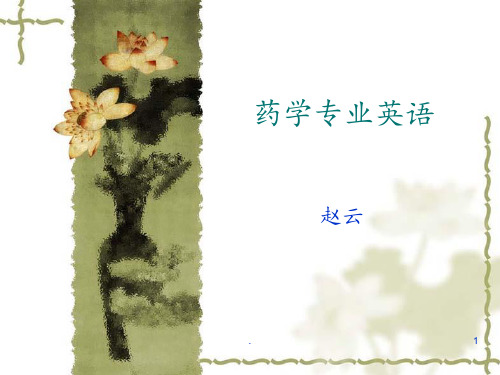关于医学英语论文标题写作的文体特点课件
- 格式:ppt
- 大小:436.00 KB
- 文档页数:19






医学英语的文体特点1.句法特点1.1名词化所谓名词化,是指在其他文体里用动词、形容词较多,而在像医学英语这类科技英语中则常常把动词、形容词转化为名词或名词短语。
例如:the application of acupuncture to the treatmemt of these diseases 较之apply acupuncture to treat these diseases更多见于医学英语文献中。
名词化结构的常用形式包括:(1)名词十of十短语,如:the flow of blood from the heart to the infected area.这种形式多用于表示行为对象。
(2)用by引导的短语表示行为执行者,如:the intake of sufficient blood by the infecteted Area(3)保留原来动词或形容词的搭配关系,如:this association of radiation with benign and malignant thyroid diseases.(放射疗法与良性和恶性甲状腺疾病的这种联系)/The importance of irradiation as an etiologic factor in the development of human thyroid carcinoma is well documented.辐射作为一种致癌因素,在成人甲状腺癌产生中的重要作用已被充分证明。
总之,名词化结构是由名词化的词作中心词,加上不同的修饰语构成的短语,其形式不外乎以下几种:(1)前置十中心词transient obstruction 暂时阻塞/ intravaecular coagulation 血管内凝血/ preoperative cardiac cathererization 术前心导管梭查(2)中心词+后置production of the platelet plug 血小板栓的形成/ overview of platelet function 血小板功能概述/ release from platelets of several medicators 从血小板释放出来的几种介质(3)前置+中心词+后置the increased use of noninvasive cardiovascular technology 更多地应用非创伤性心血管诊断技术/lower concentration of megnesium in their heart muscle 较低的心肌镁的含量(4)of短语前移selection of material→material selection / removal of the needle→the needle removal(5)复杂的名词化结构名词化结构中的中心词或所修饰成分枝节旁生,叠加修饰,包括别的短语或从句,从而形成一个较长的名词化结构,如:a decision making process used for the development of a new therapy for which there is a human need 为研制人类所需要的一种新疗法而进行的决策过程/ the exponential rise in the quantity of medical literature being published in this rapidly developing filed在这个快速发展的领域中,医学文献出版数量呈指数的增长医学英语等科技文体因为大量使用名词化结构,使得原本要用一个句子所要表达的内容以短语的形式表现,从而使句子结构紧凑,表达简洁,例如:Although/because/ when/ after/ before/ while/the specimen /is/ was/ has been examined under the microscope这种带连词的分句,可分别简化为:in spite of/ because of/ on/ after/ before examination of the specimen under the microscope/ during examining the specimen under the microscope不仅如此,名词化的使用还可使文章更具严密性。